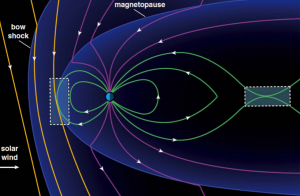New Tech Helps Solve the Twin Mysteries of Magnetic Reconnection and the Aurora
New Tech Helps Solve the Twin Mysteries of Magnetic Reconnection and the Aurora
New electron-imaging technology just gave NASA scientists new insight into how the magnetic field lines around the Earth reconstitute themselves, as well as the source of both space weather and the Aurora Borealis. Researchers previously knew that magnetic reconnection was taking place, but never had the means to measure it because they lacked equipment capable of measure plasma reactions fast enough to get a read on interactions taking place at the electron scale. Enter NASA’s Magnetospheric Multiscale, to which we owe the new data. MMS comprises four satellites designed to make the kind of rapid electron measurements required to probe the reconnection region.
Dr. James Burch of the Southwest Research Institute in San Antonio describes using MMS as looking at the electrons with a microscope as opposed to a telescope. The system represents the first chance we’ve had to measure data unfolding so quickly and at such a microscopic level. We now know that electrons accelerate through what’s called a near magnetic null, then follow a meandering path from inside the magnetosphere, where they mix with particles from Earth’s magnetic field, to back outside of it, where they mix with particles from the Sun’s magnetic field. This motion facilitates an electric current that connects the two fields.

Everything that was measured before was either measured with particle detectors or optically — like looking at solar flares — but either way, all anybody measured until now was the effects of reconnection, Burch explains. “Nobody had ever measured the source of it. Now, we’ve caught up with all the computer simulations, we’ve moved ahead of them. The next thing we want to study is, what produces this electron field?”
The MMS data has been 11 years in the making. Burch and his team were selected for the project in May 2005, and it’s taken the intervening time to design and build and fly MMS — it launched a year ago — and now to analyze the data. The device was built for the sole purpose of studying magnetic reconnection.
The practical implications for our newfound ability to study and analyze the phenomenon are unknown, but also highly promising. Since magnetic reconnection is responsible for space weather, like solar flares and coronal mass ejections — plus, closer to home, the Aurora Borealis — this new insight might help us get better forecasts. That’s not necessarily the objective of MMS’s upcoming mission next year, which will study the tail of the magnetosphere where the field lines that connect to the “day” side have to disconnect to the “night” side, but the data gathered will almost certainly help.
It also has the potential to one day permanently solve the energy crisis. The more we understand about magnetic reconnection, the closer we get to understanding magnetic confinement fusion. (Not cold fusion — this is a separate area of research. Plus, said Burch sternly, ”cold fusion doesn’t exist.”)
Right now, there are big machines studying magnetic confinement fusion, trying to confine plasmas heat, Burch said. “They can confine the plasma, it’s when they heat it up that reconnection sets in and then it can escape, it’s not confined anymore. But if they can do it, it’s a long shot but … we’re definitely studying it.”
by Kastalia Medrano For Inverse
Be the first to post a message!
